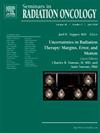Principles and Paradigms of De-Escalated Elective Nodal Irradiation: Boldly Going Towards an Inflection Point in Head and Neck Radiotherapy
IF 3.2
3区 医学
Q3 ONCOLOGY
引用次数: 0
Abstract
Fundamental axioms of elective nodal irradiation (ENI) for head and neck cancers merit re-examination in contemporary practice. Standard ENI doses to volumes bordering critical organs-at-risk increased during the transition from two-dimensional radiation planning to intensity-modulated radiotherapy, despite improvements in detection of occult nodal metastases with modern imaging, use of concurrent chemotherapy, and identification of human papillomavirus (HPV)-related radiosensitivity. Historical large ENI volumes covering low-risk nodal regions continue to be commonly used even as awareness grows regarding the predominant pattern-of-failure within existing gross disease. In this review, we outline principles for de-escalating head and neck ENI dose and volume and highlight the emerging paradigm of ENI omission. We also propose a three-part approach to ENI de-escalation, the rationale for early adoption of de-escalated ENI in the absence of level-one evidence, and strategies to promote early adoption in light of modest equipoise and an inflection point towards changing the status quo.
降压选择性淋巴结照射的原则和范例:大胆走向头颈部放疗的拐点
选择性淋巴结照射(ENI)治疗头颈癌的基本原理值得在当代实践中重新审视。在从二维放射计划向调强放疗过渡期间,尽管现代成像技术在隐匿淋巴结转移的检测、同步化疗的使用和人乳头瘤病毒(HPV)相关放射敏感性的鉴定方面有所改善,但关键危险器官周边体积的标准ENI剂量增加了。覆盖低风险淋巴结区域的历史大ENI量继续被普遍使用,即使人们对现有总体疾病中主要的失败模式的认识不断提高。在这篇综述中,我们概述了降低头颈部ENI剂量和体积的原则,并强调了新兴的ENI遗漏范例。我们还提出了一个由三部分组成的ENI降级方法,在缺乏一级证据的情况下早期采用降级ENI的理由,以及根据适度平衡和改变现状的拐点促进早期采用的策略。
本文章由计算机程序翻译,如有差异,请以英文原文为准。
求助全文
约1分钟内获得全文
求助全文
来源期刊
CiteScore
5.80
自引率
0.00%
发文量
48
审稿时长
>12 weeks
期刊介绍:
Each issue of Seminars in Radiation Oncology is compiled by a guest editor to address a specific topic in the specialty, presenting definitive information on areas of rapid change and development. A significant number of articles report new scientific information. Topics covered include tumor biology, diagnosis, medical and surgical management of the patient, and new technologies.

 求助内容:
求助内容: 应助结果提醒方式:
应助结果提醒方式:


